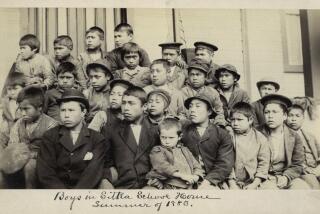California missions: How textbooks evolved to reflect the plight of Native Americans
Anyone who goes looking into California mission stories that were written decades ago is likely to come upon some language that’s jarring, if not downright offensive, words such as “savage,” referring to Native Americans.
The more you read, the more you see that, during the last century, California’s textbooks and newspapers have dramatically changed their descriptions of the Spanish mission system. Today, most writers show greater respect for Native Americans and are more likely to acknowledge the forced labor, fatal diseases and cultural repression that the Spanish brought to California along with Christianity, literacy and agriculture.
The result is that when researchers look back at old writings, they not only learn about the 18th and 19th centuries, but they also learn about the writer’s presumptions.
Explore all of California’s 21 famed missions >>
In the archives of the Los Angeles Times, a 1924 article about San Juan Capistrano tells how Father Junípero Serra befriended the American Indians, “some savage, none civilized,” and “soon had them walking in the white man’s path.”
A 1957 article about Mission San Antonio de Padua discusses the padres’ “much more difficult feat of raising the natives to the white man’s level.”
The pages of The Times have historically reflected the attitudes of society at large.
As long ago as 1938, the paper’s internal usage guide urged reporters and editors to “exercise care in all racial references” and cautioned them against slurs, but those were often overlooked when it came to the Germans and Japanese during World War II.
The Times style guide didn’t offer specific guidance on indigenous peoples until 1995, when it advocated, “depending on the subject’s choice,” the terms “Native American” or “American Indian.” That fits with the paper’s approach of being more sensitive to cultural diversity and changes in language and societal attitudes.
As for the state’s textbooks, these excerpts show an evolution.
1922
“California’s Story,” by Herbert E. Bolton and Ephraim D. Adams
Published by Allyn & Bacon for use by California grade schools
“The friars treated the Indians kindly, as if they were children. But sometimes the Indians ran away, because they did not like to work, and preferred the free life of the mountains and valleys.”
1948
“California Beginnings,” by Lola B. Hoffman
Published by the California State Department of Education
“Everyone was happy and busy. Padre Serra went from garden to field. He preached. He carried loads of wood as the Indians did. He taught the little children the lessons of the church. He taught them how to sing and how to play the violin and flute. ...
“In 14 years, he had helped change a large part of the desert into rich farm land. He had helped make thousands of poor, half-starved savages into happy, bustling workers.”
1965
“California’s Own History,” by John and LaRee Caughey
Published by the California State Department of Education
“The Indians at the missions ate more regularly than when they were wild. The padres took care of them in many ways. The Indians had the feeling of being part of something much bigger than the old Indian village. They learned to do many things as the Spaniards did. They learned many new skills. On the whole, they must have felt better off than before.”
1991
“Oh, California,” published by Houghton Mifflin Co.
“Mission Indians were not allowed to return to their tribes once they agreed to take part in mission life. Some ran away. But soldiers usually brought them back, and sometimes whipped them. ...
“Many Indians died of diseases brought by the Spanish. When crops failed, Indians didn’t have enough to eat. Some became sick from the change in their diet on the missions. By the end of the mission period, the California Indian population was half the size that it had been when Father Serra raised his first cross at San Diego Mission.”
2006
“Our California: History-Social Science for California,”
Published by Scott-Foresman, still used in many schools
“The missionaries wanted the California Indians to come to the missions. They gave them gifts such as beads, clothing and food so they would live in the missions. There these California Indians learned how to farm and make new things.
“However, once they came to the missions, some California Indians were not free to leave. They were forced to give up their way of life and work hard. They also had to learn Spanish and follow Catholicism, the religion of the Catholic church. Many died from diseases, such as measles and smallpox, that were brought over by Europeans.
“A few California Indians fought against the mission system. Some of this resistance was violent. For example, California Indians destroyed the San Diego mission in 1775. Others never joined a mission. They chose to stay on their lands and keep their ways of life.”
More to Read
Sign up for The Wild
We’ll help you find the best places to hike, bike and run, as well as the perfect silent spots for meditation and yoga.
You may occasionally receive promotional content from the Los Angeles Times.







